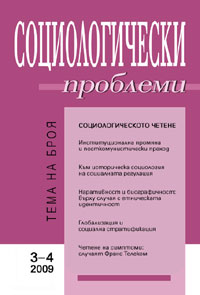Еволюцията в посткомунистическите страни: интерпретация от позициите на кооперацията
The Evolution of Post-communist Countries: An Interpretation from the Perspective of Cooperation
Author(s): Nikolay Nenovsky, Dimiter S. IalnazovSubject(s): Social Sciences
Published by: Институт по философия и социология при БАН
Summary/Abstract: How do we account for the difficulties that former socialist countries experienced in the beginning of transition? Why is it that some countries performed relatively better (the Baltic and Central European countries) than others (Bulgaria and Romania)? Why in the second half of 1990s, and especially immediately before the EU enlargement, almost all of the former Soviet bloc countries achieved better results? And how can we explain the problems facing the new member-states after they joined the EU and euro funds began to flow in? In short, the basic hypothesis we present is the following: both the transition phases and the diversity of trajectories of post-communist countries are the result of the difference in prevailing strategic behaviors. This difference determines the models of cooperation, namely the two main archetypes: that of the prisoner’s dilemma and the stag hunter. These two archetypal societal models are on their part conditional on the existence of external and internal anchors. While with the prisoner’s dilemma especially when noisy environment and social heterogeneity exist it is profitable not to cooperate, under the stag hunter model (a model involving a common project) advantageous in general are cooperative strategies. The various countries in different phases can be approximated to either one or the other game – the prisoner’s dilemma or the stag hunter. A shift to the cooperative game becomes possible as a result of the operation of internal or external anchors. For instance, in the beginning of the transition, with no clear vision in sight amid an outburst of large diversity of economic and social actors, and old system’s information channels falling to pieces, the appropriate analytical model to apply would be the prisoner’s dilemma. And vice versa, later on, especially when a decision was adopted to join the EU and with pre-accession chapters being opened and closed, i.e. an external anchor emerging, appropriate for analytical reasoning becomes the stag hunter game model.
Journal: Социологически проблеми
- Issue Year: 41/2009
- Issue No: 3-4
- Page Range: 156-173
- Page Count: 18
- Language: Bulgarian
- Content File-PDF

